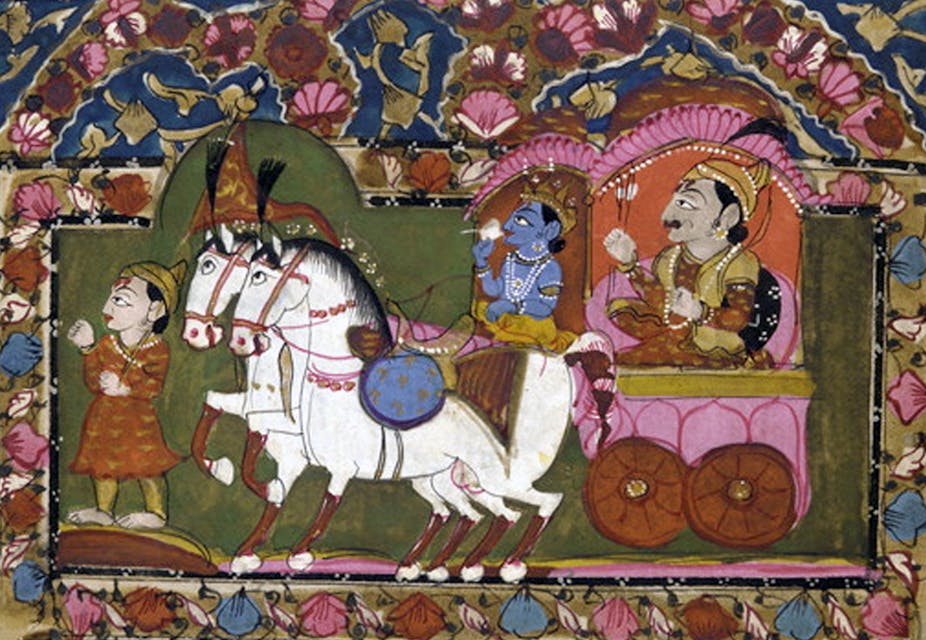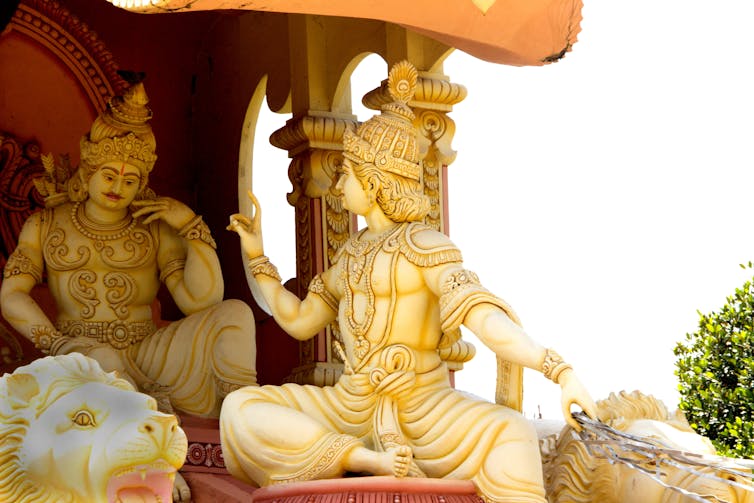
What the ancient Indian text Bhagavad Gita can teach about not putting too much of our identity and emotions into work
We believe in the free flow of information
Republish our articles for free, online or in print, under a Creative Commons license.

An analysis of data from 60,000 employees by BambooHR, an HR software platform, also found that workplace morale was getting worse: “Employees aren’t experiencing highs or lows — instead, they are expressing a sense of resignation or even apathy.”
As a scholar of South Asian religions, I argue that a mindfulness technique called “nishkama karma” – acting without desire – described in an ancient but popular Indian text called the “Bhagavad Gita,” may prove useful for navigating the contemporary world of work.
The Gita presents a variety of “yogas,” or disciplined religious paths. One such path suggests adopting an attitude of righteous resignation – a kind of Stoic equanimity or even-mindedness. In the workplace, this might mean performing one’s professional duties to the best of one’s ability – but without being overly concerned about the results for one’s personal advancement.
The Gita and action
The “Bhagavad Gita,” or “Song of the Lord,” is an 18-chapter dialogue between Krishna, the Lord of the Universe, and the warrior-hero Arjuna. Found in the sixth book of the world’s longest epic poem, the “Mahabharata,” the Gita was likely composed between the third century B.C.E. and the third century C.E.
The Gita opens on a battlefield where Arjuna, the beleaguered champion of the Pandavas, is set to fight his cousins, the Kauravas, along with his uncles and former teachers, for the rightful control of the ancestral kingdom.
Arjuna is faced with the moral ambiguity of internecine warfare. He is stuck in a dilemma between obligations to his kin and former teachers and obligations to his “dharma” – religious and social duty – as a warrior to fight against them. Arjuna is therefore understandably reluctant to act.
Krishna, who has assumed the humble guise of Arjuna’s charioteer in the story, advises Arjuna that it is impossible for anyone to refrain entirely from all action: “There is no one who can remain without action even for a moment. Indeed, all beings are compelled to act by their qualities born of material nature” (3.5).
Even choosing not to act is itself a kind of action. Krishna instructs Arjuna to perform his duties as a warrior regardless of how he feels about the prospect of fighting against family and friends: “Fight for the sake of duty, treating alike happiness and distress, loss and gain, victory and defeat. Fulfilling your responsibility in this way, you will never incur sin” (2.38).
Given the inevitability of action, Krishna advises Arjuna to cultivate an attitude of nonattached equanimity or even-mindedness toward the results of his actions. Unlike feeling detached from the work process itself, cultivating an attitude of detachment from the results of one’s work is presented in the Gita as a method for gaining a clear and stable mind.
‘Nishkama karma,’ or nonattached action
The term that the Gita uses, variously rendered as “work” or “action,” is “karma.” Derived from the Sanskrit root “kri” – to do, to act or to make, karma has a range of meanings in Hindu literature. In early Vedic thought, karma referred to the performance of a sacrifice and the results that followed.
By the time of the composition of the Gita, over a 1,000 years later, the concept of karma had expanded considerably. From the sixth century B.C.E. onward, Hindu texts typically describe karma as any thought, word or deed, and its consequences in this or a future lifetime.

Krishna explains to Arjuna that his actions or karma should follow dharma, the religious and social obligations inherent in his role as a warrior of the Pandavas. And the proper dharmic attitude toward the results of action is nonattachment.
The word that describes this nonattachment is “nishkama,” or without desire – the proper spirit in which karma is to be undertaken. From the perspective of the Gita – a perspective shared widely in traditional Indian thought – desire is inherently problematic due to its insistent preoccupation with the self. By reducing desire, however, one can perform one’s work or action without the constant distraction of seeking praise or avoiding blame.
Furthermore, since knowing the outcome of one’s actions is impossible, the Gita advises performing one’s duties without a sense of ego in a spirit of service to the world. “Therefore, without attachment, always do whatever action has to be done; for it is through acting without attachment that one attains the highest state,” as Krishna says to Arjuna (3.19).
The flow state
In his modern classic “Flow: The Psychology of Optimal Experience,” psychologist Mihaly Csikszentmihalyi writes about the optimal mental state that may be experienced while performing an engaging task. Csikszentmihalyi describes “flow” as a mental state where one is fully immersed in the task at hand. In such a state, attention is focused on the work being done without any self-conscious concerns about performance or outcome.
By way of example, Csikszentmihalyi asked readers to consider downhill skiing. He noted that while one is fully engaged in the process itself, there is no place for distraction. For a skier, he said, “There is no room in your awareness for conflicts and contradictions; you know that distracting thought or emotion might get you buried face down in the snow.”
Csikszentmihalyi’s research suggests that problems like distraction, feeling detached from one’s work, and job dissatisfaction can arise when people lose sight of the action of work itself. As Csikszentmihalyi writes, “The problem arises when people are so fixated on what they want to achieve that they cease to derive pleasure from the present. When that happens, they forfeit their chance of contentment.”
Acting without attachment
A fragmented mind that approaches work or action with an agenda of gaining power, wealth or fame cannot perform at its best. The Gita suggests that the secret to success at work is cultivating a balanced state of mind that isn’t fixated on ego inflation and self-promotion.
It is impossible to be fully present during the performance of a task if one is speculating about unknowable future contingencies or ruminating about past outcomes. Likewise, for Csikszentmihalyi, cultivating the “flow state” means actively remaining present and engaged while performing a task.
Csikszentmihalyi’s writings about the “flow state” resonate with the advice of Krishna in the Gita: “As ignorant people perform their duties with attachment to the results, O scion of Bharat (an epithet for Arjuna), so should the wise act without attachment, for the sake of leading people on the right path” (3.25).
Author
Disclosure statement
Robert J. Stephens does not work for, consult, own shares in or receive funding from any company or organization that would benefit from this article, and has disclosed no relevant affiliations beyond their academic appointment.
Partners
Nishkama karma and the “flow state” are not identical ideas. However, they share at least one fundamental assumption: Focusing on the task at hand, with no thought of gain or loss, is necessary for achieving our best, most satisfying work.
